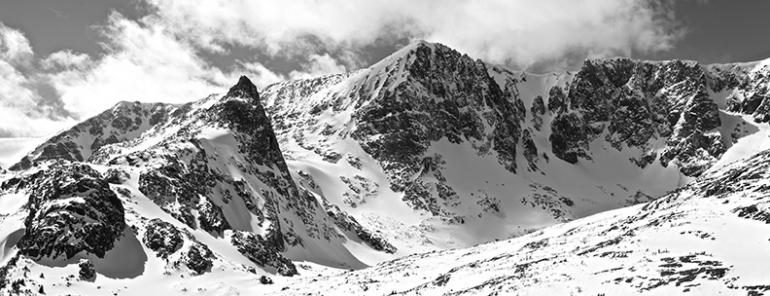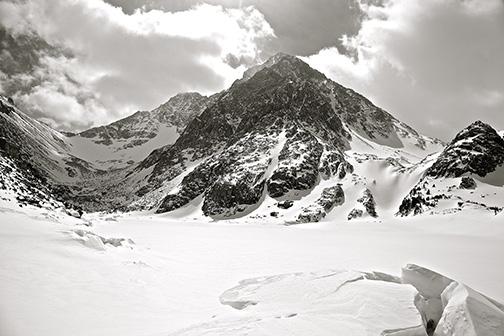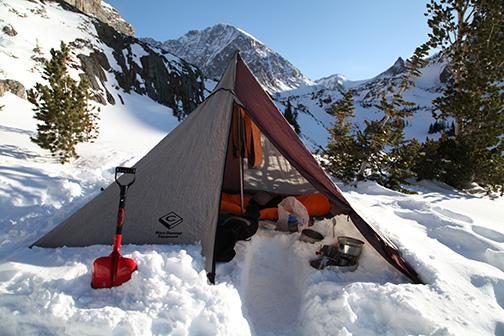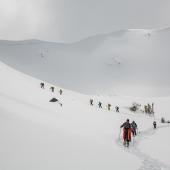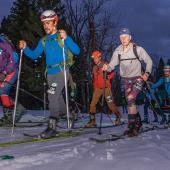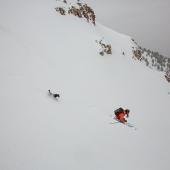Beartooth Beat-Down
Almost climbing Granite Peak.
A week or two before I plan to climb Granite Peak in the Beartooths, field biologists issue a public advisory that the bears of Yellowstone are emerging from their dens. They say north aspects of remote mountain valleys, between elevations of 7,000-9,000 feet, located in and around Yellowstone National Park, are likely to have bear activity. Check, check, and check. And I’m solo. Perfect.
I decide to carry my .45 with me. This is ski mountaineering, Montana style. Not that a .45 would do much to discourage a hungry griz. Perhaps the best argument for a pistol is that it makes a lot of noise. Other than that, the hunk of steel on my hip may be nothing more than training weight and peace of mind. I can always save the last bullet for myself. I carry pepper spray as well—just to flavor the meal. It’s with visions of grizzlies dancing in my head that I leave my truck and head into the wild for four days with a flask of whiskey and a loaded pistol—and 80 pounds of other crap.
The trail is mostly clear, so I hike with skis strapped to my pack. I pass the familiar granite slabs and Absaroka-Beartooth Wilderness sign before ascending the first of many switchbacks.
Reaching the Mystic Lake overlook, I see a thin layer of wet snow and standing water covering the ice. After waxing up the skins, I go shuffling across the ice—picking my line like a polar bear on Arctic flows—and make it to a decent campsite with plenty of daylight. I’ve made good time and still have energy for tomorrow. And no bear sign yet.
The next day dawns promising—I’m up at a reasonable hour, breakfasted, packed, and ready to go. Five minutes of skinning uphill to the south, and I start to think, This isn’t so bad. That’s when the Easy Button shits the bed.
Dense forest, steep terrain, and boulder hopping on skis with a giant pack totally harshes my mellow. And those neatly drawn, contiguous trails depicted on the map? They’re as elusive as a Bozeman bachelorette. After searching high and low, I find no evidence to suggest that they exist. Bushwhacking it is.
I struggle uphill against the grain of every tree and bush in the vegetation-choked drainage. A snow bridge over a creek partially collapses, leaving me teetering on my left ski, sliding backwards, flailing to keep my right ski out of the drink. Channeling one part ballerina and another part gorilla, I balance and hurl myself forward and sideways onto the far bank, legs drawn up like an Olympic downhiller.
Clawing my way up the creek bank, I emerge from the jungle-brush into the first open space I’ve seen since camp: Huckleberry Lake. Great talus fields rise to my left, while primordial old-growth timber dominates the north and east aspects of the secluded mountain scene. If I was a bear, this is where I would den.
I want to say I stood there and called out “HEY BEAR” half-a-dozen times, listening to my voice reverberate among the valley walls. But it was probably more like 30 or 40. There is something comforting about the sound of your own voice when alone in the wilderness.
There are few summit options from Huckleberry Lake, and they all involve hellacious bushwhacking, scary talus-hopping, or both. I opt for a gully on the southwestern flank that will hopefully spit me out at Princess Lake. The gully is steep enough to slide, and there is one wind pillow that concerns me—it’s big enough to add a bit of stress to the slab. I skirt the edge of a talus flow and switchback my way up without incident.
The terrain opens up above Princess Lake. I stop for lunch and study the walls of rock and snow. Weather is rolling in and I’m not sure how long I’ll have good visibility. There is a marked difference between the timbered gully behind me and the rocky slopes above me: the trees are thinning out and the slopes ahead are far more exposed—dramatically increasing the potential for avalanches.
I pick the best bad idea and go for it. Crossing Princess Lake, the weather begins to deteriorate in earnest, and along with wind-driven graupel, a chill sets in—although I can’t tell if it’s the temperature dropping or my concern about the avalanche paths I’m about to enter. I find a poorly defined spine and slog up the crest of it, reaching a point where I cannot skin anymore. Booting through thin windslab reveals a foot or more of sugary facets sitting on the underlying cobbles and scree.
I churn through the rotten snow like an icebreaker through spring pack ice. There are thicker slabs to either side of me and soon I’ll have to cross one of them. The terrain forces me left and the slab I’m busting through is getting thicker. I cannot safely go forward.
Back on skis, I make a high-speed ski-cut across the top of the avalanche path. Nothing happens and I feel a moment of relief. But the process of breaking trail with a full pack, deliberating over the route, and dealing with increasingly cold, windy, wet weather is draining. I find a treed outcrop and haul myself up. From there, my route to Cold Lake becomes clear.
I move on, unable to stand still very long in the damp spring cold. The route wends through talus, over old glacial moraines. At times, I find myself crossing surprisingly steep drifts and wonder how it would feel to get cheese-grated through the rocks by a slab just big enough to sweep me off my feet.
I top out in a cloud. Visibility is only a few feet and I can’t see the lake that must be right below. I stand among the boulders, ruminating for too long about what to do next—my original goal was to reach Avalanche Lake. The grinding cold fogs my brain. I bump down to the shore of aptly named Cold Lake and set up camp. I sleep well to the pitter-patter of snow falling softly on the nylon walls, cascading in tiny, catastrophic avalanches from time to time.
Morning breaks crisp and clear—three to four inches of snow having fallen overnight, with a bit of wind. I’ve already decided not to go for the summit. I know I’m not fit enough, and I didn’t make it high enough yesterday. Today will be a scouting mission for another trip.
After a leisurely breakfast, it’s time to stretch my legs. The saving grace of the whole trip is the frozen lakes—superhighways compared to the surrounding obstructions. I cross Cold Lake and ascend the talus slope beyond, weaving around house-sized blocks.
There’s such a vastness to this place—the plutonic mountain massifs, the expansive boulder fields, the Yosemite-scale granite slabs, even the seemingly small lakes are deceptively huge. The whole venue feels Himalayan: around every corner I expect to come face-to-face with a snow leopard, or maybe cross the trail of a Yeti. Lunch at Avalanche Lake is spectacular. I scope out the route to the saddle between Granite Peak and Froze-to-Death Plateau, and briefly consider going there. Knowing I’ll be tempted to start the climb if I do that, I think better of it and simply take time to enjoy the high-mountain environment.
Returning to the trailhead the next day, I’m oddly content, despite the fact that I came nowhere close to summiting. I carried a heavy pack high into the mountains, suffered enough to feel like I had done something, stayed safe, made good decisions, and learned a lot for the next time I try to climb Granite Peak.
But actually summiting? That’s another story.

